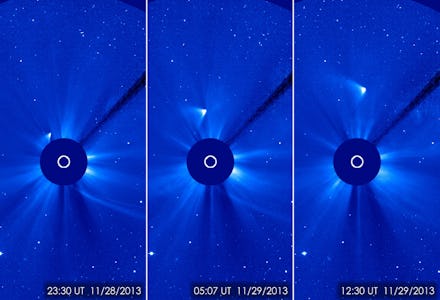These GIFs Show What Happened to Comet ISON As It Skidded Across the Sun

On Thursday, comet C/2012 S1 (better known as ISON) skidded across the surface of the Sun, running through the unimaginable heat and light that emanates from the corona of the solar body. Amazingly, something managed to survive and shoot out the other side.
But what came out, exactly?
Something. It was initially unclear whether the comet completely disintegrated and what's emerged is a cloud of high-velocity dust, or part of the comet had survived and would continue its journey across the stars.
NASA's Karl Battams provided these thrilling high-resolution animations of ISON crossing the Sun's path and emerging:
(Note that these were taken from completely opposite sides of the Sun by NASA's STEREO Ahead and STEREO Behind spacecrafts. Pretty cool, right?)
NASA doesn't have any firm convictions about comet's actual fate, though they've garnered a lot more than they previously knew. Battam "hesitantly" leans towards the hypothesis that there's something left producing a new trail of dust, either a small nucleus or "a pile of rubble and comet chunks" that will fall apart in the near future. ISON is too faint and near the Sun to determine whether or not the comet is still trailing gas, which would be firm proof of a surviving nucleus.
Here's how Slate's Phil Plait described the emerging data available on ISON on Monday:
"... As we get more images of the comet as it heads away from the Sun, its ultimate fate is perhaps a little easier to see. The NASA / ESA spacecraft SOHO has been observing the comet since it entered its field of view on Nov. 28, and has told an interesting if somewhat head-scratchy tale. The solid nucleus of the comet started out about two kilometers wide, and got very bright. It faded rapidly as it approached the Sun, pretty much the opposite of what you might expect. But then it got bright again after it rounded the Sun, though not nearly as bright as before. And now it appears to be fading without stop."
Before it flew through the worst the Sun had to offer, ISON was approximately two kilometers wide composed of rock, gravel, and dust held together by ice. It originated from the Oort Cloud, a near-unending belt of such chunks far beyond Neptune, and was on what appeared to be an escape trajectory from the solar system - meaning that even if it has survived its encounter with the Sun, there's a good chance that whatever is left will be unceremoniously ejected into deep space, never to be seen again.